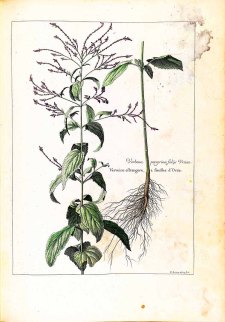It isn’t just through book learning that plants can be understood. Observation of the shapes, colours and forms of the plants behind our remedies – as well as their habits and habitats – can speak volumes. The ideal is to study the plants in nature, using all the senses, but the more I have studied botanical illustrations, drawn by so many different hands, the more I see how, in the best of them, the spirit of the plant appears to pass through the artist into the drawing. This is a gift towards understanding more about the plants as medicines too.
Verbena officinalis is a herb we don’t yet have a homeopathic proving of. We have hints from Bach’s flower essence Vervain (same plant, common name); from the plant’s long history of herbal use; and from the medicinal action of its close botanical cousins Vitex agnus castus and plants of the mint family. There is a theme in these remedies of how we expend our energy and desires, and of balancing hormones. You could say they are about libido, but that is too limiting a term; they are also about lust for life and creative energy.
One of Verbena officinalis’ main traditional herbal uses has been to relax the mind, heightening the imaginative and intuitive powers. It loosens the grip on prosaic, repetitive worries, allowing movement into unconscious thoughts. Poets and storytellers once drank infusions of Verbena to inspire creativity and facilitate improvisation and fluidity of ideas. Familiar stories or poems could be recited again and again, but with inspiring new accents on each delivery. Druids used the plant for divining the future. And the North American Indians called on local varieties of Verbena to encourage vivid, prophetic dreams.
Verbena officinalis was dedicated to the Ancient Greek goddess of dawn, Eos, whose tears were morning dew. The plant’s associations are with the borders of sleep and wakefulness. The richly creative time between the dream world and the daylight world of consciousness is the key to many of Verbena’s associations and uses. In herbal medicine and as a Bach flower essence (Vervain), it is prescribed for those people who live overly in their head, not fully in their body. They can be rigid thinkers, determined planners, sometimes verging on the fanatical; there is no time to dream or allow fluidity. When overdone, this nervous tension can be their weak point. I have used it to help those who overextend themselves in this way, especially where it’s blocking their creativity. Not surprisingly, they experience tension in the musculoskeletal system too.
So how does this relate to botanical art? In the images accompanying this post, you can see how various illustrators have depicted the plant. When I looked at these drawings, my immediate thought was, ah, overextension… I had never seen so many illustrations of a plant pushing towards the boundaries of the page like this. It’s as if each of the artists independently started drawing, thinking they had things in proportion, but somehow Verbena always took their pen to the limits of the allotted space. And if it wasnt pushing up through to the top of the frame, it had to bend and divert sideways…. an energy overextending in a restricted space.




Images: Verbena officinalis L.: Bonelli, Giorgio, Hortus Romanus juxta Systema Tournefortianum, vol. 3: t. 56 (1783-1816); Collection des vélins du Muséum national d’histoire naturelle, vol. 19: t. 21 () [unsigned]; Dodart, D., Recueil des plantes gravées par ordre du roi Louis XIV, vol. 3: t. 156 (1788); Bulliard, P., Herbier de la France, vol. 6: t. 215 (1776-1783) [P. Bulliard]